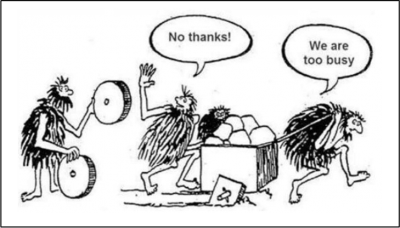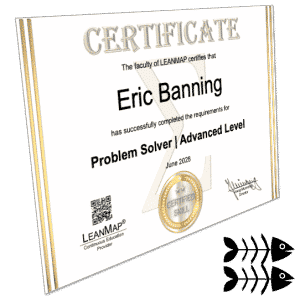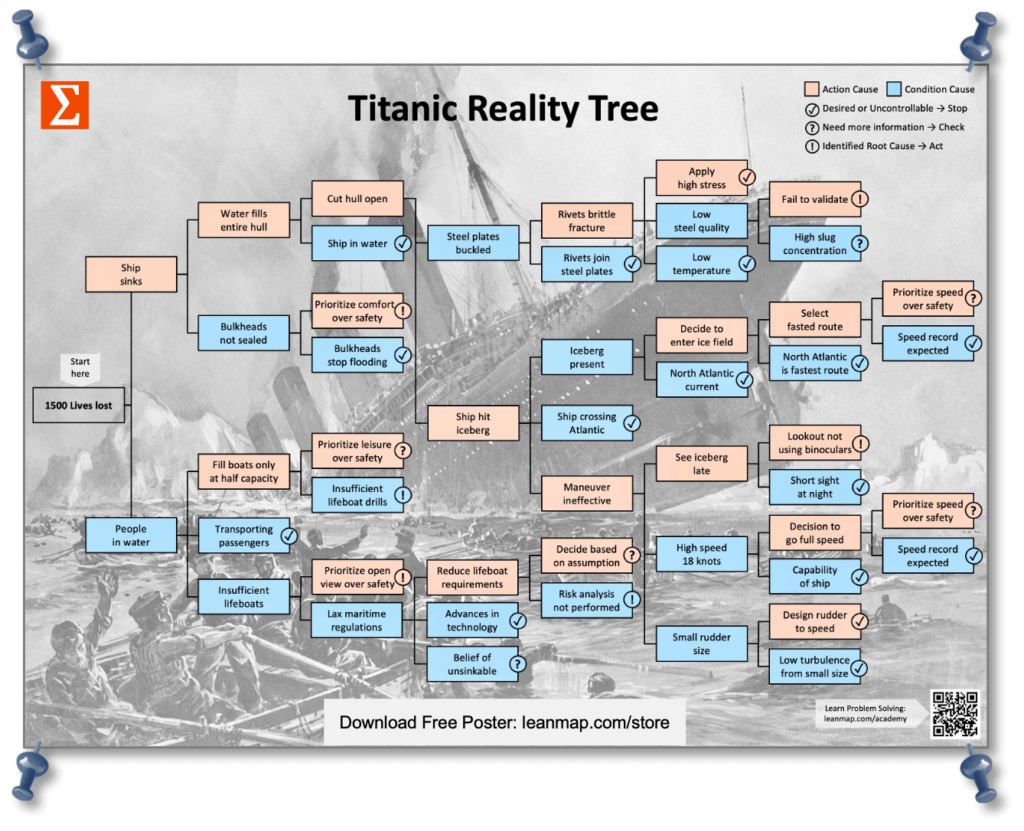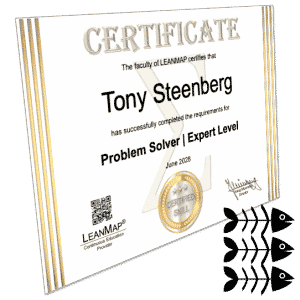Problem solving training for result-driven managers and functional specialists to effectively eliminate the root causes of variability, gaps, defects, frustrations, and stress.
Cases, when to use:
- Frustration from never-ending fire-fighting
- Excessive defects, uncontrolled variability
- Stress from unhappy boss, customer, spouse
- Working too hard, too late, risking burnout
Clients, for whom:
- Department managers and team leaders
- Functional specialists, engineers, controllers
- Consultants and improvement champions
- Anyone struggling with too many problems
Process, how it works:
- Online training course with personal coaching
- Apply 5 shifts to successfully address any problem
- Eliminate causes at physical, human, system root
- Learn proven strategies; practical templates included
Benefits, what to gain:
- Status and recognition as expert problem solver
- Become indispensable to the organization
- Free time to spend with family, friends, hobby
- Strategy for better pay and career advancement
Course Content - What You Will Learn
- Systematically solve safety, quality, reliability issues
- Define issue statements based on data, observations
- Learn proven tools and techniques to tackle deviations
- Use basic PDCA and 5-Why analysis for simple issues
- Use Causal Factor Analysis (CFA) for disasters, accidents
- Use Fault Tree Analysis (FTA) for rule-based problems
- Identify cause-effect relationships between factors
- Provide evidence to confirm or reject assumptions
- Drill down causes at the physical, human, latent root
- Develop actions to remove, reduce, control causes
The 13 Reasons for Formal Problem Solving
- Undesirable condition
- Deviation, defect, failure
- Safety accident, incident, major risk
- Product failure due to strength, performance, reliability
- Line stop event
- Regulatory non-compliance
- Customer dissatisfaction or request
- Cost overrun
- Equipment breakdown
- Process failure
- Behavioral issue, noncompliant, disengaged
- Repetitive or transferable problem
- Detection failure
Ineffective Trouble Shooting

- Quick fix
- Fire fighting
- Going from crisis to crisis
- Stagnant or declining performance
- No time for deeper analysis
- Look for the guilty party: ”Who did that?”
- Jumping from problem into actions
- Generate laundry list of actions to firefight symptoms
- Sub-optimizing one area, spot scope
- Focus on lagging metrics (yield, sales, profits) and hope processes will improve as a result
Effective Problem Solving

- Systems thinking
- Continuous improvement
- Systematic root cause elimination
- Better performance after each problem
- Allocate time to analyze, dialogue, conclude
- Seek deep understanding: “How did that happen?”
- Acting after understanding cause-effect relationships
- Addressing all factors of the failure tree
- Optimizing the value stream, enterprise scope
- Focus on improving processes (capability) that effect actual performance metrics
The Problem Solving Training Gets You Certified
The Beginner Problem Solving Training helps anyone to get started with systematic problem solving. Within a few days, you will learn the basic methods and tools, and apply them to solve a difficult situation in five steps: (1) Describe Gap, (2) Analyze Issues, (3) Identify Causes, (4) Address Causes, (5) Evaluate Results. Quizzes and self-evaluation forms help you to test your skills and evaluate solution the effectiveness of your solutions.
The Advanced Problem Solving Training is for managers, supervisors, and functional specialists to build their their problem-solving skills. The course focuses on systematic root-cause analysis and developing countermeasures to effectively contain, correct, and prevent failures from reoccurring. The advanced course is supported by a coach, helping students through the process, while providing feedback to get the analysis right.
The Expert Problem Solving Training is for engineers, managers, and quality professionals to build expert skills in systematic problem solving. The course covers the deep analysis of event-based problems, rule-based problems and human failures. The expert toolkit allows you tackling deviations and defects at the system level by eliminating, reducing, and controlling the entire set of causes, identified on the logic tree – assisted by an experienced coach.

Problem Solver | Basic Skills
Online course for beginners to build foundational skills to identify, describe, contain, correct, and prevent simple problems from reoccurring.

Problem Solver | Advanced Skills
Coaching-supported advanced course to strengthen problem-solving skills, to deeply analyze and effectively address identified root causes.
Basic Problem Solver
Level-1-
100% online and self-certified, without coaching
-
Build basic skills in systematic problem solving
-
Ideal for beginners from any function, any level
-
Formally analyze and solve a basic problem
-
Takes 2-5 days effort during a 1-month period
-
Get access to basic videos, templates, toolkit
-
Apply multi-5-why to identify root causes
-
Formally implement a solution using PDCA
-
Create financial benefits; typ. $3k or more
-
Get your certificate "Problem Solver"
Advanced Problem Solver
Level-2-
Coaching sessions for business case and impact
-
Build advanced skills in problem-solving
-
Ideal for managers, supervisors, specialists
-
Solve an advanced problem and get feedback
-
Takes 5-10 days effort during a 2-month period
-
Get access to advanced videos, templates, tools
-
Perform root cause analysis and test robustness
-
Formally implement solutions, test effectiveness
-
Create financial benefits; typ. $30k or more
-
Get your certificate "Advanced Problem Solver"
Expert Problem Solver
Level-3-
Coaching sessions, expert validation, live support
-
Build expert skills in systematic problem solving
-
For engineers. managers, quality professionals
-
Solve a major problem, supported by a coach
-
Takes 10-20 days effort during a 3-month period
-
Get access to expert videos, templates, toolkit
-
Identify physical, human, and latent causes
-
Formally eliminate, reduce, control causes
-
Create financial benefits; typ. $60k or more
-
Get your certificate "Expert Problem Solver"



